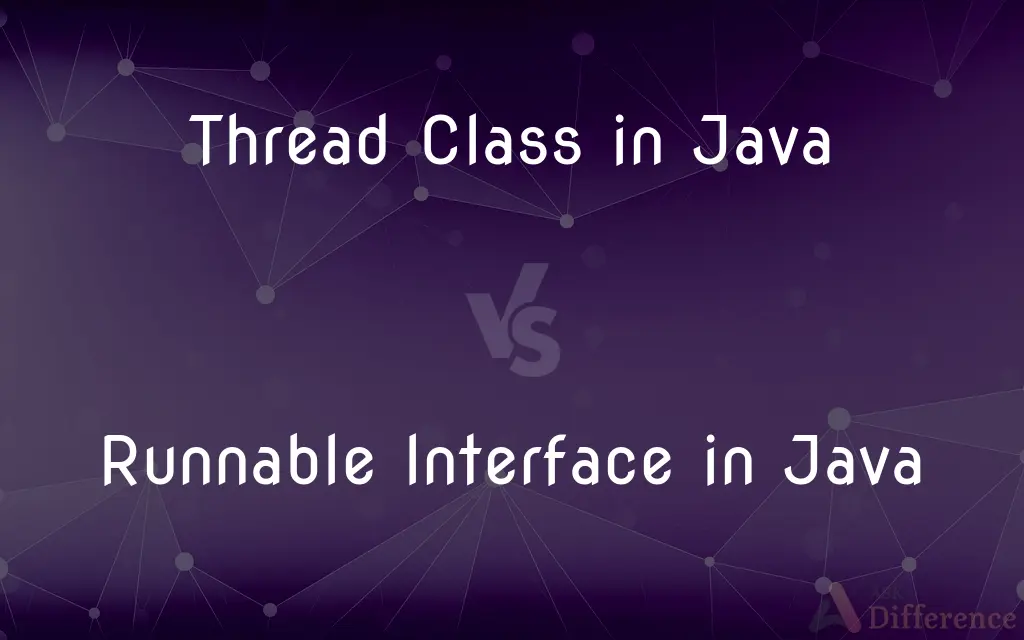Thread Class in Java vs. Runnable Interface in Java — What's the Difference?
By Tayyaba Rehman — Published on January 6, 2024
'Thread Class in Java' extends the Thread class, allowing direct thread creation, while 'Runnable Interface in Java' requires implementing the run() method, promoting multiple inheritances and flexibility.

Difference Between Thread Class in Java and Runnable Interface in Java
Table of Contents
ADVERTISEMENT
Key Differences
The Thread Class in Java represents a thread, allowing direct thread creation by extending the Thread class. It offers features like priority control, interrupt handling, and thread lifecycle management.
On the other hand, the Runnable Interface in Java declares a single run() method that needs implementation. It offers a more flexible approach as classes can implement multiple interfaces, promoting better design and code reuse.
Utilizing the Thread class means a class extends the Thread class directly. This can limit further inheritance as Java does not support multiple inheritances, restricting the class to extending only one class.
Implementing the Runnable interface allows a class to extend another class while still implementing the Runnable interface, promoting a more flexible code structure with multiple inheritances.
Thread objects in Java can be directly created using constructors. This class provides methods like start(), run(), sleep(), etc., directly accessible to the thread objects.
ADVERTISEMENT
Classes implementing the Runnable interface need to define the run() method, which contains the code executed in a separate thread, offering a more generalized approach to handling threads.
Comparison Chart
Inheritance
Extends Thread class
Implements Runnable interface
Multiple Inheritance
Restricts additional inheritance due to single extension
Allows multiple inheritance alongside extending other classes
Flexibility
Limits class extension, fewer opportunities for reuse
Enhances code flexibility, enables multiple inheritances and reuse opportunities
Method Implementation
Directly creates threads using constructors
Requires implementation of the run() method
Code Structure
Offers direct thread management capabilities
Promotes a more generalized approach to thread handling
Compare with Definitions
Thread Class in Java
Inherits thread-specific methods.
The 'Thread' class includes methods like start(), join(), and sleep().
Runnable Interface in Java
Enhances design flexibility.
Implementing 'Runnable' allows better flexibility in class design.
Thread Class in Java
Provides lifecycle management.
Using 'Thread' manages thread lifecycle states - new, runnable, and terminated.
Runnable Interface in Java
Encourages code reuse.
Using 'Runnable' promotes code reuse across various classes.
Thread Class in Java
Represents a thread directly.
Extending 'Thread' allows for direct thread management.
Runnable Interface in Java
Promotes multiple inheritances.
Classes can implement 'Runnable' while extending other classes for flexibility.
Thread Class in Java
Offers priority control.
Thread priority can be managed using 'setPriority()' from the 'Thread' class.
Runnable Interface in Java
Defines a run() method.
Implementing 'Runnable' requires defining the 'run()' method for thread logic.
Thread Class in Java
Limits multiple inheritances.
Extending 'Thread' class restricts inheriting from other classes.
Runnable Interface in Java
Offers generalized thread handling.
The 'Runnable' interface abstracts thread logic for various class implementations.
Common Curiosities
Can a thread stop another thread in Java?
No, one thread cannot forcefully stop another thread in Java.
Can a class extend other classes while extending Thread?
No, Java doesn’t allow multiple inheritance, limiting it to one class extension.
Can multiple classes implement the Runnable interface?
Yes, multiple classes can implement the Runnable interface in Java.
Can a class extend another class while implementing Runnable?
Yes, implementing Runnable doesn’t affect the ability to extend other classes.
Does implementing Runnable create a separate thread?
No, Runnable provides the logic to be executed by a thread but doesn't create one.
Can you directly start a thread implemented through Runnable?
Yes, a Thread object can execute the run() method defined in a Runnable instance.
Can a thread have a return value?
Threads in Java don’t return values directly. You can use shared variables or other synchronization techniques.
Does implementing Runnable ensure thread safety?
No, the Runnable interface doesn’t guarantee thread safety on its own.
Can the run() method of a Thread object be called directly?
Yes, but calling run() directly doesn’t create a new thread; it's just a regular method call.
Can threads be named?
Yes, threads can be named using the setName() method or passing the name in the constructor.
Is it mandatory to call the start() method for Runnable?
Yes, to create a new thread from a Runnable, start() must be invoked.
Can Runnable instances be reused?
Yes, Runnable instances can be used to create multiple threads, promoting reusability.
Can Thread objects run without calling start()?
Yes, but calling the start() method is essential to spawn a new thread and execute its run() method.
Are there any other methods besides run() in the Runnable interface?
No, the Runnable interface in Java only contains the run() method to be implemented.
Can interfaces extend the Thread class?
No, interfaces can't extend classes in Java, including the Thread class.
Share Your Discovery

Next Comparison
Complete Ionic Equation vs. Net Ionic EquationAuthor Spotlight
Written by
Tayyaba RehmanTayyaba Rehman is a distinguished writer, currently serving as a primary contributor to askdifference.com. As a researcher in semantics and etymology, Tayyaba's passion for the complexity of languages and their distinctions has found a perfect home on the platform. Tayyaba delves into the intricacies of language, distinguishing between commonly confused words and phrases, thereby providing clarity for readers worldwide.













































